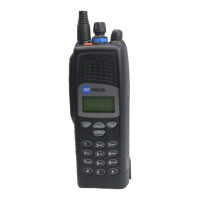252 Receiver Fault Finding TP9100 Service Manual
© Tait Electronics Limited May 2005
11.1 Faulty Receiver Sensitivity
Introduction This section covers the determination of the extent of the receiver’s loss of
sensitivity. Depending on the nature of the fault, a reduction in receiver
sensitivity of 1dB is often due to a reduction in receiver gain of many
decibels. It is therefore easier to measure gain loss rather than sensitivity loss.
Consequently, if the receiver sensitivity is too low, first check the receiver
gain. The procedure is given in Task 1 below.
Task 1 —
Determine Extent
of Sensitivity Loss
Determine the receiver gain as follows. The corresponding loss of sensitivity
can then be deduced. Depending on the extent of the loss, continue with
“Excessive Loss of Sensitivity” on page 253 or “Moderate or Slight Loss of
Sensitivity” on page 258 to rectify the fault.
1. Input an RF signal (not necessarily modulated) of –90dBm at the RF
connector.
2. Enter the CCTM command 378 to measure the receiver output level.
3. Note the value x returned for the receiver output level. Depending
on the frequency band in which the radio operates, the value should
be:
Note that a change in the input level of 10dB should result in a ten-
fold change in x.
4. If necessary, measure the RF voltage at the
QN test point TP444
(see Figure 12.5). For comparison, the voltages corresponding to the
above values of x are:
With an unmodulated RF signal the frequency should be 64.000kHz,
provided that the LO1, FCL and LO2 are locked and on the correct
frequency.
5. Given the value of x, go to the relevant section as follows:
■ x < 1500, go to “Excessive Loss of Sensitivity” on page 253
(sensitivity is very low)
■ x < 500 000, go to “Moderate or Slight Loss of Sensitivity” on
page 258 (sensitivity is low)
receiver output level x: normally between 500 000 and 6 000 000
x = 500 000: 12mV
pp
x = 6000 000: 120mV
pp

